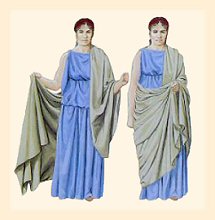Ancient Roman Attires for Males and Females: The dress was a very significant indicator of social and economic status in the Ancient Roman civilization. The material most commonly used was wool as it was most easily available. Use of hemp and linen was also common. However, silk was used rarely and only for the women’s clothes. It was not considered masculine enough.
Ancient Roman Attires
The clothes were woven on vertical looms. Since the needles were not very refined and the art of tailoring was still in its infancy, the clothes were often draped across the body. Buttonholes were impossible. Instead, a wide variety of knots, brooches, clasps etc were used to hold the clothes together.
The Male costumes
Men wore a simple loincloth made of linen as the undergarment. It was knotted on both sides. It has been known by different names like Subligar, Lycium, Cinctus etc. The basic garment was the tunic. It was worn by people from every walk of life. it was decorated in different ways.

In Roman Attires, These decorations indicated the wealth of the person. Also, there were symbols on the tunic to denote a person’s rank in society. Such symbols were stripes of different colors placed in different positions. The tunics were knee length and had short sleeves. They could also be sleeveless. Long sleeves were not considered masculine at all till much later.
The most impressive garment was the toga. Only the free Roman citizens were allowed to wear the toga. It was a large blanket draped over the body and held together by fastenings in such a way as to leave one arm bare. The toga was white as dictated by the law. It was a symbol of power and status.
The female Costumes
The undergarment of the women consisted of a tight band of linen worn like a brassiere. The tunic was the basic garment. Sometimes more than one tunic was worn on top of each other to ward off the cold. The tunics were long, reaching up to the ankles.

Long sleeves were a must. Sometimes a short tunic was worn over a longer one. Rich women had ornamental borders along the hem of the tunics. Wool was the most common material while silk could be afforded by only a few. The women’s tunics were called stola.
A cloak was worn over the tunic. The earliest version was called the Ricinium but it was later replaced by the palla. The length was variable. It could be as small as a scarf or can be draped over the whole body and held together by ornamental fastenings.
Several types of footwear like the caller (soft leather shoe), sandals (sandals) and Socci (informal slippers) were worn by both the sexes.



